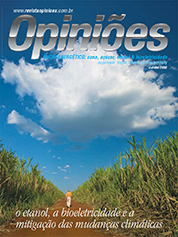Ricardo Rose
Environment Director of the Brazilian-German Chamber of Commerce
Op-AA-22
A world increasingly against GHG emissions
The Brazilian alcohol program, “Proálcool”, began in 1975, as a reaction to high oil prices, following the first oil crisis. The number of alcohol-powered cars produced increased gradually, reaching 95% of the country’s total family car output in 1996. In the 90’s, for a short period, alcohol producers could not meet the market’s total demand.
At the same time, the oil barrel price declined in the international market, reducing the gasoline price. These factors resulted in a decline in sales of alcohol-powered cars, replaced by gasoline cars. Only in the beginning of the current decade, the demand for ethanol-powered vehicles again began to increase a little.
However, it was a technological innovation – the development of a sensor that detects the oxygen level in the fuel – that made it possible to build dual-fuel engines (“flex-fuel”), beginning in 2003. Thus, consumers enjoyed the advantage of the low price and had the assuredness of the fuel’s supply, resulting in that the demand for dual-fuel vehicles increased quickly, reaching 90% of total sales.
Following Brazil’s example, several countries implemented dual-fuel programs. The European Union has a well-developed biodiesel program and has also started using ethanol mixed with gasoline. In Germany, for example, biofuel represents 5.9% of fuel consumption and 5.25% of ethanol is already being added to gasoline – a percentage expected to increase to 6.25% in 2010.
Most of this fuel is produced locally, from beet, corn and oat sugar. The big expectation on the part of Brazilian ethanol producers is that they might sell larger volumes to Europe, since their price is competitive in comparison with European ethanol. However, there are still barriers to increasing exports. On the one hand, there are non-tariff barriers, such as the negotiation of a Brazilian ethanol certificate in compliance with certain technical, environmental and social standards; on the other hand, there is still pressure from the European public opinion, which is ill-advised and believes that sugarcane competes with the production of food.
Finally, the subsidies for European agriculture continue being granted, making access of agricultural products to that market difficult. Bioelectricity is the most important sub-product of the sugar and alcohol industry in Brazil, currently generating, on average, about 1,400MW. The technology applied to incinerating sugarcane bagasse is not new, having been used in some mills to generate power for self-consumption since the 60’s.
However, economic interest was awakened in the 90’s, when the legal framework was created for a private entrepreneur to be able to sell electric power to a distribution company. Notwithstanding still low compensation levels in comparison with the several implementation costs, bioelectricity has a very high growth potential.
According to a study by UNICA, The Brazilian Sugarcane Industry Association, by 2020/2021 mills will be able to produce a total of 13,150MW, roughly one and a half times the capacity of the Itaipu complex. In Germany, about 15% of electric power is obtained from renewable sources. Power from biomass represents about 60% of all renewable power generated in the country, in addition to wind, solar and geothermal energy.
Biomass is also used to generate large volumes of steam, apart from bioelectricity. Steam is intended for industrial processes and for heating homes. In Germany, in 2007, electric power produced from biomass – not including power generated from biogas, which is also quite significant – totaled 6.6 billion KWh. Half of the approximately 150 Brazilian projects approved by the UNO under the Kyoto Protocol’s Clean Development Mechanism relate to cogeneration (bioelectricity) projects.
The trend is that the number of initiatives in this field will further increase, since production and transportation are increasingly being targeted by those concerned about the increase of greenhouse gases in the atmosphere. Both sectors – mainly in the industrialized countries – have been the largest polluting gas generators. Another aspect is that the concept of “decarbonization” of productive processes, products and services will, in a few years, be a part of our everyday lives. We will be faced with an economy increasingly contrary to greenhouse gases that are the cause of climate change.





